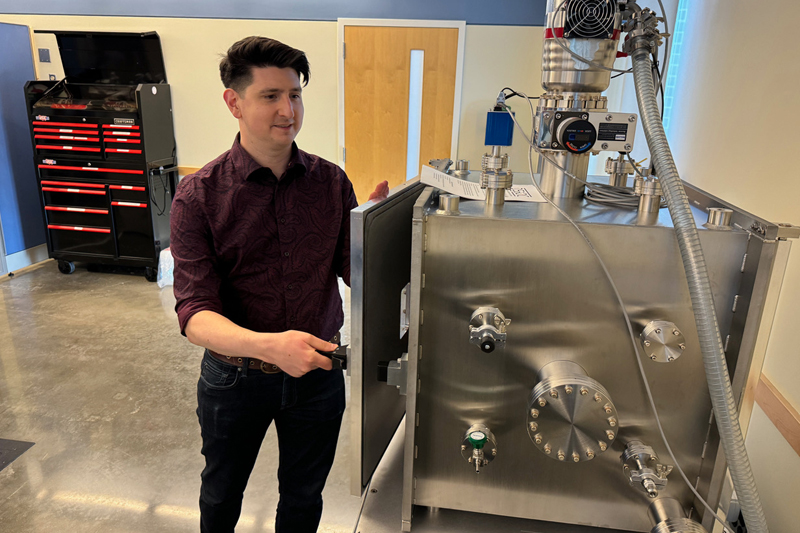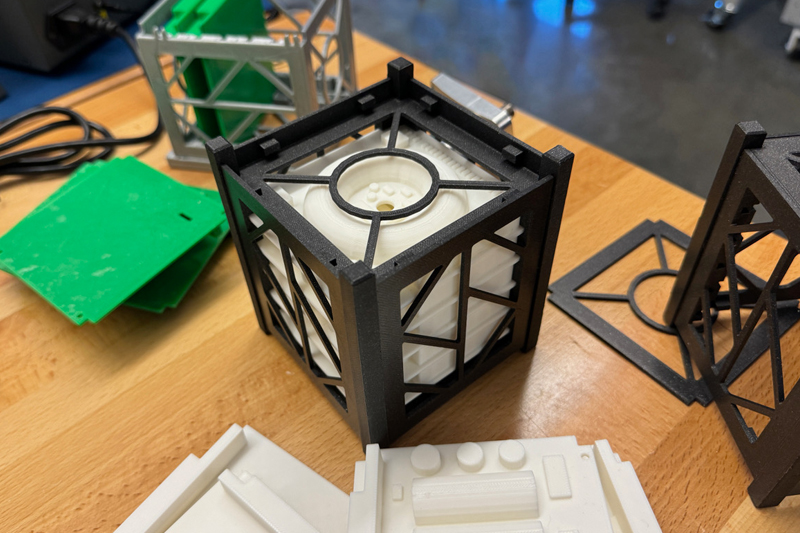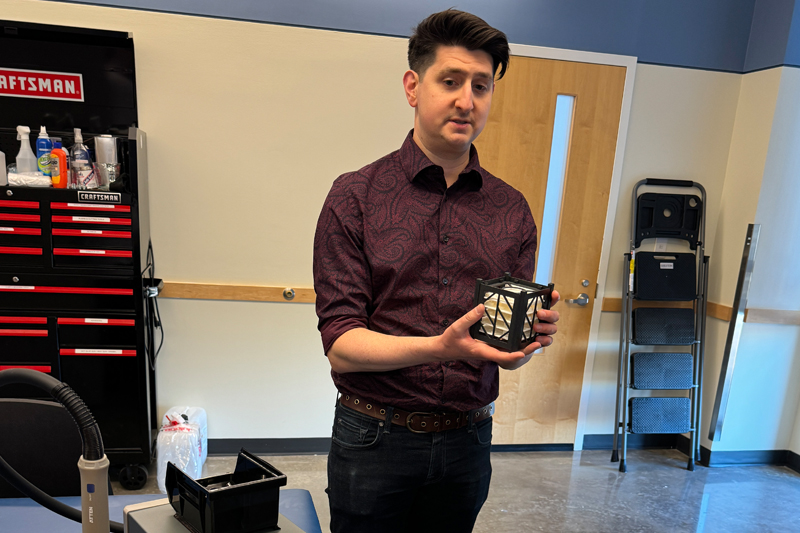


Making Delaware-in-space history
Photos by David Barczak April 17, 2024
NASA selects UD’s CubeSat spacecraft for upcoming mission
Students pursue higher education with worthwhile goals in mind. They want to learn from experts, explore more of the world, earn a degree, find a good job and contribute to a better future.
It’s safe to say that not many expect to lead a NASA-supported mission during their undergraduate studies. But at least a dozen University of Delaware students will have done that by the time they collect their diplomas in the next few years.
All are part of a team creating Delaware’s first orbital spacecraft, which was selected by NASA for launch in 2026 as part of its CubeSat Launch Initiative. The NASA program, which started in 2011, aims to give students an opportunity to be part of real missions and gain extraordinary experience in what it takes to do space research.
CubeSats are small, modular, inexpensive satellites that carry experiments for science investigations and/or technology demonstrations. About 160 CubeSats have been launched in the NASA program over the years, many deployed from the International Space Station (ISS).
Delaware’s mission — the Delaware Atmospheric Plasma Probe Experiment (DAPPEr) — will launch its CubeSat spacecraft from the ISS and orbit independently through Earth’s upper atmosphere.
The CubeSat will be about the size of a loaf of bread, according to the team’s faculty mentor, Bennett Maruca, associate professor of physics and astronomy. It will gather data about the density and temperature of electrons in Earth’s upper atmosphere, recording changes observed at different latitudes and times of day. This data will inform future research on how the sun affects conditions there.
Understanding the sun’s interaction with the Earth’s atmosphere is critical to development of satellite communications networks, global positioning systems (GPS) and national security.
But the real objective is educational, Maruca said. The students are the “deliverables.” They’ll emerge from this work with an insider’s view of what it’s like to develop and work on a NASA mission.
“I am a deliverable and I’m honored to be one,” said Amanda Swenson, a sophomore astrophysics major from Islip, New York, who is on DAPPEr’s science team. “I have learned so much about what I could be doing in the future.”

In addition to developing experiments and building CubeSats, team members are seeing what it takes to make proposals to NASA, navigate its paperwork and comply with exacting regulations — work that prepares them for future missions as researchers and/or NASA employees.
It has already been an “incredible journey,” Timothy “T.J.” Tomaszewski said. The journey started last August, when Maruca first suggested doing a CubeSat project.
“To go from proof of concept to being accepted by NASA, it has been one of the best experiences of my life,” Tomaszewski said.
And now he is the project manager — as a sophomore.
“I’ve always been interested in space, ever since I was a kid looking up at the moon at night,” he said. “With this, I have learned about science and myself. I didn’t know I wanted to do scientific management or run a mission.”
Swenson said she was shocked when Tomaszewski texted her last summer and said “Do you want to build a satellite?”
“How can I say no to that?” she said. “It has been the best experience in general and learning-wise. I’ve learned a lot not only about the science, but how to function as a team and about time management. And the reward of getting an approval as monumental as NASA’s — well, it’s an amazing experience I never thought I’d be able to have.”
Developing space science research
Maruca, an expert in space plasma physics, is the principal investigator of the mission, which is supported by the new Delaware Space Observation Center (DSpOC) and NASA grants, in partnership with the Delaware Space Grant Consortium (DESGC). Students also receive support from faculty advisers in their majors, which include physics, astronomy, mechanical engineering, electrical engineering and biomedical engineering.
Maruca has led student teams that developed experiments that were launched aboard sounding rockets from NASA’s Wallops Island Space Flight Center in Virginia.
“This has been on my radar for a while,” he said. “The sounding rockets were where we wanted to begin, going into orbit and measuring plasma at higher altitudes. This will be Delaware’s first orbital spacecraft, and we don’t want it to be the last.”

Students on the DAPPEr mission will build on the work of students who went before them, including those who helped establish the UD CubeSat Ground Station, a 10-foot satellite dish installed on the grounds of the Mount Cuba Astronomical Observatory (MCAO) in Greenville, Delaware. That ground station will enable communication with the DAPPEr CubeSat and also will be part of NASA’s upcoming CURIE CubeSat mission, led by the University of California, Berkeley, which is expected to launch this summer. (CURIE stands for CubeSat Radio Interferometry Experiment.)
Maruca’s DSpOC recently acquired a thermal vacuum chamber and the center also has a clean area, both of which are essential to assembling and testing the CubeSat.
Developing a NASA mission is not for the faint of heart. It requires attention to detail, many forms and reports, deadlines and the ability to handle pressure.
Humor is not required, but Maruca adds it often to the mix.
This explains the DAPPEr team’s blue fedora logo.
“Flight missions are incredibly stressful,” Maruca said. “There are late nights and panic getting ready for reviews. It’s important to also have fun and have a sense of belonging and team spirit.”
Preparing for extreme conditions
Creating a CubeSat that can function independently and withstand the extreme conditions in the Earth’s ionosphere is no small matter.
Delaware’s DAPPEr mission will launch from the ISS to what is known as the F2 layer of Earth’s ionosphere, about 425 kilometers (264 miles) above the surface.
“The ionosphere is where the auroras live,” Maruca said. “These are the altitudes where auroras are forming. It’s where a lot of spacecraft are and the materials on these spacecraft are affected by plasma.”
Because the mission aims to gather data in “pristine” plasma, the Langmuir probes that capture plasma data cannot just be mounted outside the Space Station.
“You’d be dealing with the wake of the ISS,” Maruca said. “And that disrupts the plasma.”
Once it is launched from the ISS, the CubeSat will drift away into orbit — all on its own. The tiny spacecraft must have its own power generation and its own communications system.
Electromagnets will help the spacecraft push against the Earth’s magnetic field, Maruca said, as the CubeSat has no other propulsion capability.
For power, the team will use space-grade lithium polymer batteries, he said.
“They’re not that different in terms of technology from the batteries in our phones or laptops, but they are space-rated, designed to withstand the extreme temperatures, pressures or lack thereof — which is why they cost so much.”
The total cost for parts is just over $200,000, Maruca said, with one of the solar panels costing about $7,000, he said.
“It has to be able to withstand the vibrations of launch,” he said, “and it has to be lightweight.”
The CubeSat also must be able to tolerate extensive temperature changes and thermal cycling from low extremes of minus 40 degrees Celsius (and Fahrenheit) to maximum extremes about 80 degrees Celsius (180 degrees Fahrenheit).
“There is so little gas there, the temperature of the gas doesn’t really matter to the temperature of the spacecraft,” Maruca said. “What matters is how much light it’s exposed to. In the sunlight, it will get very hot. When it passes into the Earth’s shadow, it will get very cold. And in Earth orbit, you’re in and out of that every 90 minutes. That’s why you test not only the temperature but also the thermal cycling.”
In that thin atmosphere, the air does not conduct heat as efficiently to or from the spacecraft, he said.
For the same reason, your skin reacts much differently to brief exposures to the heat of an oven and the lower temperature of boiling water, he said.
If you put your hands into an oven heated to 375 degrees Fahrenheit and then remove them, your hands may be warm, but they won’t be burned.
However, if you are boiling water for pasta and put your hands into that 212-degree Fahrenheit liquid, your hands will be burned because the density of that lower-temperature water is far greater than the density of the air in the oven.
Communications and spacecraft commands will be generated from the CubeSat Ground Station at Mount Cuba. The ground station will send and receive data to and from the spacecraft.
It is a slow process, though — nothing like livestreaming a movie over high-bandwidth internet connections.
“These are dial-up modem speeds,” Maruca said. “It’s a trickle. You have to do as much onboard processing as possible.”
The mission is designed to continue for at least six months, during which the spacecraft will make many orbits. The team hopes it will continue to operate for a year, to collect more data and see long-term patterns such as average temperatures in summer months and winter months.
In addition to Tomaszewski and Swenson, UD’s CubeSat team members include (so far) Samuel Auerbach, mechanical engineering, Narberth, Pennsylvania; Marisol Catalan Olais, physics, Wilmington, Delaware; Sreenidhi Banda, biomedical engineering, Pike Creek, Delaware; Matthew Ward, electrical engineering, Newark, Delaware; Connor McCleery, mechanical engineering, Wilmington, Delaware; Alex Bruce, physics, Abington, Pennsylvania; Jonathan Rosado, mechanical engineering, Fallston, Maryland; Markos Duey, mechanical and aerospace engineering, Wilmington, Delaware; Jarrod Bieber, physics, Middletown, Delaware; and Josh Goodwill, physics, Pittsburgh, Pennsylvania.
Also selected for launch by NASA were CubeSat missions from the University of Louisiana at Lafayette; Oakwood School in California; the University of Hawaii at Manoa; California State University, Long Beach; Saint Louis University; California State Polytechnic University, Pomona; University of Chicago; Utah State University; and NASA’s Marshall Space Flight Center (in partnership with Massachusetts Institute of Technology and Georgia Institute of Technology).
Contact Us
Have a UDaily story idea?
Contact us at ocm@udel.edu
Members of the press
Contact us at 302-831-NEWS or visit the Media Relations website

